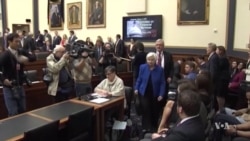President Donald Trump is expected to name Jerome Powell as the new head of the U.S. central bank.
Trump is scheduled to formally announce the pick Thursday in the White House Rose Garden.
“I think you will be extremely impressed by this person!” he teased in a Twitter post.
WATCH: Who Will Be the Next Fed Chief?
Sucessor to Yellen
The Wall Street Journal, citing unnamed sources, reported late Wednesday that White House officials have notified Powell that he will replace Federal Reserve Chair Janet Yellen when her term expires early next year. Other media outlets also said Powell is Trump’s choice.
Powell is one of the Federal Reserve’s governors. Analysts say he is a Republican centrist who appears inclined to continue the Fed’s strategy of gradually raising interest rates. The Journal story cautioned that Trump, who has praised Yellen recently, might still change his mind.
Powell would be a middle-ground pick for Trump, who is also considering current Fed Chair Yellen as well as Stanford University economist John Taylor and former Fed Governor Kevin Warsh.
Powell may relax rules
While Powell is expected to continue Yellen’s cautious approach to raising interest rates, economists say he might relax some of the financial rules designed to prevent another financial crisis like the one that caused chaos in the markets during the 2007-2008 recession. Trump has complained that those rules hurt banks and economic growth. Yellen, who was selected as Fed chair by President Barack Obama, has been an outspoken advocate for the stricter financial regulations that took effect in 2010.
Many conservative members of Congress had been pushing Trump to select Taylor, rather than Powell, for Fed chairman. Taylor, one of the country’s leading academics in the area of Fed policy, would likely embrace a more “hawkish’’ approach, more inclined to raise rates to fight inflation than to keep rates low to support the job market. Taylor is the author of a widely cited policy rule that provides a mathematical formula for guiding rate decisions. By one version of that rule, rates would be at least double what they are now.









